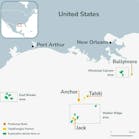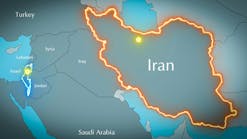Kuwait is making progress toward restoration of its sabotaged oil industry.
Well control companies last week were preparing to kill Kuwait's last blazing well, less than 7 months after field work began in mid-April. On Oct. 28, 18 Kuwaiti wells still had to be killed. An unspecified number of sabotaged wells in the Neutral Zone between Kuwait and Saudi Arabia remained out of control, restoration manager Bechtel Inc. said.
In addition, Kuwait's oil production has risen to 290,000 b/d. F. Al-Jasem, deputy managing director of production for Kuwait Oil Co., predicts production will jump to 400,000-500,000 b/d by yearend, 750,000-800,000 b/d by June 1992, and hit the prewar level of 1.5 million b/d well before the end of 1992.
New wells will play a major role in restoring production. Five rigs are running, five more are to be put to work by the first of 1992, and more will be added during the year.
Al-Jasem said 170,000 b/d of capacity is back in operation at one of the country's three refineries outside the Neutral Zone. And the 187,000 b/d, "all hydrogen" Shuaiba refinery is under study to determine the best way to bring it back on line.
Kuwait National Petroleum Co. has resumed local sales of 15 types of lube oil after restarting its lube oil plant south of Kuwait City.
WELL CONTROL PROGRAM
After Kuwait was liberated last February, some observers predicted 2-5 years would be needed to kill the 749 Kuwaiti wells sabotaged by fleeing Iraqi troops.
Kuwaiti officials plan to celebrate the successful end of history's largest well control project by relighting one well Nov. 6 and ceremoniously snuffing it again.
Bechtel said the campaign to restore Kuwait's war ravaged petroleum industry has been one of the construction industry's fastest, biggest mobilizations.
Since asked last January by Kuwait to lead the project, Bechtel helped muster more than 9,000 workers and 125,000 tons of heavy equipment and supplies.
Bechtel early in March began moving employees into the region.
Early work involved damage assessment, planning, engineering, procurement, and construction services to support massing workers for the restoration project, dubbed Al-Awda, meaning "The Return."
Significant firsts in Al-Awda chronology include:
- Mar. 4-First Bechtel staffers arrive in Kuwait.
- Apr. 14-First laborers in the field force arrive in Kuwait.
- May 26-Kuwait begins pumping the first oil through two gathering centers.
- May 30-First air cargo is cleared to land at Kuwait International Airport. Deliveries of cargo by sea begin soon after.
FACTS AND FIGURES
With the massive emergency oil field operation nearing completion, Bechtel has begun reporting facts and figures that indicate the scope of the well control effort:
- The 9,000 workers amassed to extinguish well fires and kill wild wells came from 37 countries on five continents. Included in the multinational work force were 27 ten man firefighting teams from 10 countries-Canada, China, France, Great Britain, Hungary, Iran, Kuwait, Romania, Russia, and the U.S.
General laborers came from Afghanistan, Australia, Bangladesh, Bahrain, Belgium, Brazil, Colombia, Djibouti, Egypt, Germany, Netherlands, India, Indonesia, Ireland, Lebanon, Mexico, New Zealand, Nigeria, Pakistan, Philippines, Saudi Arabia, Somalia, Sri Lanka, Syria, Tanzania, Thailand, Tunisia, and Yugoslavia. Six dining halls prepared 27,000 meals/day for the workforce.
- An estimated 360 one million gal lagoons were bulldozed and lined with heavy plastic sheeting to provide water for fighting well fires. A system of water pipelines more than 90 miles long was created capable of delivering 20 million gal/day of water to Kuwaiti well sites. At the wells, pumps and hoses were able to discharge 6,000 gal/min of water onto a blaze.
- More than 4,000 pieces of equipment from 12 countries were massed on the job, including bulldozers, cranes, front end loaders, ambulances, and other support equipment from Argentina, Brazil, Canada, France, Germany, Great Britain, Greece, Italy, Kuwait, Saudi Arabia, United Arab Emirates, and the U.S.
- The medical and safety program set up for the workforce included two helicopter evacuation teams, a 40 bed field hospital, and seven medical stations staffed by 90 paramedics and other medical personnel.
Copyright 1991 Oil & Gas Journal. All Rights Reserved.


